Latest recommendations

| Id | Title | Authors▲ | Abstract | Picture | Thematic fields | Recommender | Reviewers | Submission date | |
|---|---|---|---|---|---|---|---|---|---|
02 Nov 2020

Probabilistic Modelling using Monte Carlo Simulation for Incorporating Uncertainty in Least Cost Path Results: a Roman Road Case StudyJoseph Lewis https://doi.org/10.31235/osf.io/mxas2A probabilistic method for Least Cost Path calculation.Recommended by Otis Crandell based on reviews by Georges Abou Diwan and 1 anonymous reviewerThe paper entitled “Probabilistic Modelling using Monte Carlo Simulation for Incorporating Uncertainty in Least Cost Path Results: a Roman Road Case Study” [1] submitted by J. Lewis presents an innovative approach to applying Least Cost Path (LCP) analysis to incorporate uncertainty of the Digital Elevation Model used as the topographic surface on which the path is calculated. The proposition of using Monte Carlo simulations to produce numerous LCP, each with a slightly different DEM included in the error range of the model, allows one to strengthen the method by proposing a probabilistic LCP rather than a single and arbitrary one which does not take into account the uncertainty of the topographic reconstruction. This new method is integrated in the R package leastcostpath [2]. The author tests the method using a Roman road built along a ridge in Cumbria, England. The integration of the uncertainty of the DEM, thanks to Monte Carlo simulations, shows that two paths could have the same probability to be the real LCP. One of them is indeed the path that the Roman road took. In particular, it is one of two possibilities of LCP in the south to north direction. This new probabilistic method therefore strengthens the reconstruction of past pathways, while also allowing new hypotheses to be tested, and, in this case study, to suggest that the northern part of the Roman road’s location was selected to help the northward movements. [1] Lewis, J., 2020. Probabilistic Modelling using Monte Carlo Simulation for Incorporating Uncertainty in Least Cost Path Results: a Roman Road Case Study. SocArXiv, mxas2, ver 17 peer-reviewed and recommended by PCI Archaeology, 10.31235/osf.io/mxas2. [2] Lewis, J., 2020. leastcostpath: Modelling Pathways and Movement Potential Within a Landscape. R package. Version 1.7.4. | Probabilistic Modelling using Monte Carlo Simulation for Incorporating Uncertainty in Least Cost Path Results: a Roman Road Case Study | Joseph Lewis | <p>The movement of past peoples in the landscape has been studied extensively through the use of Least Cost Path (LCP) analysis. Although methodological issues of applying LCP analysis in Archaeology have frequently been discussed, the effect of v... |  | Spatial analysis | Otis Crandell | Adam Green, Georges Abou Diwan | 2020-08-05 12:10:46 | View |
29 Jan 2024
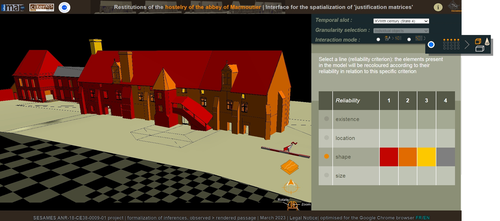
Visual encoding of a 3D virtual reconstruction's scientific justification: feedback from a proof-of-concept researchJ.Y Blaise, I.Dudek, L.Bergerot, G.Simon https://zenodo.org/record/79831633D Models, Knowledge and Visualization: a prototype for 3D virtual models according to plausible criteriaRecommended by Daniel Carvalho based on reviews by Robert Bischoff and Louise TharandtThe construction of 3D realities is deeply embedded in archaeological practices. From sites to artifacts, archaeology has dedicated itself to creating digital copies for the most varied purposes. The paper “Visual encoding of a 3D virtual reconstruction's 3 scientific justification: feedback from a proof-of-concept research” (Jean-Yves et al 2024) represents an advance, in the sense that it does not just deal with a three-dimensional theory for archaeological practice, but rather offers proposals regarding the epistemic component, how it is possible to represent knowledge through the workflow of 3D virtual reconstructions themselves. The authors aim to unite three main axes - knowledge modeling, visual encoding and 3D content reuse - (Jean-Yves et al 2024: 2), which, for all intents and purposes, form the basis of this article. With regard to the first aspect, this work questions how it is possible to transmit the knowledge we want to a 3D model and how we can optimize this epistemic component. A methodology based on plausibility criteria is offered, which, for the archaeological field, offers relevant space for reflection. Given our inability to fully understand the object or site that is the subject of the 3D representation, whether in space or time, building a method based on probabilistic categories is probably one of the most realistic approaches to the realities of the past. Thus, establishing a plausibility criterion allows the user to question the knowledge that is transmitted through the representation, and can corroborate or refute it in future situations. This is because the role of reusing these models is of great interest to the authors, a perfectly justifiable sentiment, as it encourages a critical view of scientific practices. Visual encoding is, in terms of its conjunction with knowledge practices, a key element. The notion of simplicity under Maeda's (2006) design principles not only represents a way of thinking that favors operability, but also a user-friendly design in the prototype that the authors have created. This is also visible when it comes to the reuse of parts of the models, in a chronological logic: adapting the models based on architectural elements that can be removed or molded is a testament to intelligent design, whereby instead of redoing models in their entirety, they are partially used for other purposes. All these factors come together in the final prototype, a web application that combines relational databases (RDBMS) with a data mapper (MassiveJS), using the PHP programming language. The example used is the Marmoutier Abbey hostelry, a centuries-old building which, according to the sources presented, has evolved architecturally over several centuries ((Jean-Yves et al 2024: 8). These states of the building are represented visually through architectural elements based on their existence, location, shape and size, always in terms of what is presented as being plausible. This allows not only the creation of a matrix in which various categories are related to various architectural elements, but also a visual aid, through a chromatic spectrum, of the plausibility that the authors are aiming for. In short, this is an article that seeks to rethink the degree of knowledge we can obtain through 3D visualizations and that does not take models as static, but rather realities that must be explored, recycled and reinterpreted in the light of different data, users and future research. For this reason, it is a work of great relevance to theoretical advances in 3D modeling adapted to archaeology.
References Blaise, J.-Y., Dudek, I., Bergerot, L. and Gaël, S. (2024). Visual encoding of a 3D virtual reconstruction's scientific justification: feedback from a proof-of-concept research, Zenodo, 7983163, ver. 3 peer-reviewed and recommended by Peer Community in Archaeology. https://doi.org/10.5281/zenodo.10496540 John Maeda. (2006). The Laws of Simplicity. MIT Press, Cambridge, MA, USA. | Visual encoding of a 3D virtual reconstruction's scientific justification: feedback from a proof-of-concept research | J.Y Blaise, I.Dudek, L.Bergerot, G.Simon | <p> 3D virtual reconstructions have become over the last decades a classical mean to communicate about analysts’ visions concerning past stages of development of an edifice or a site. However, they still today remain quite often a one-s... |  | Computational archaeology, Spatial analysis | Daniel Carvalho | 2023-05-30 00:43:03 | View | |
14 Mar 2024
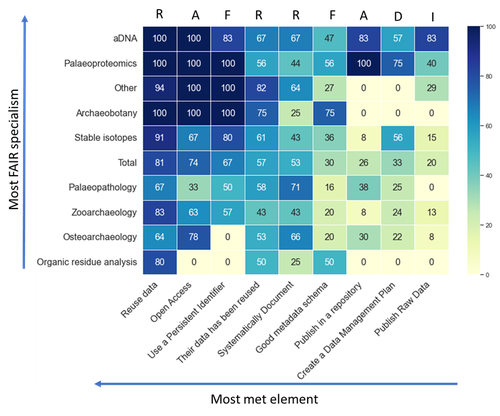
How FAIR is Bioarchaeological Data: with a particular emphasis on making archaeological science data ReusableLien-Talks, Alphaeus https://doi.org/10.5281/zenodo.8139910FAIR data in bioarchaeology - where are we at?Recommended by Claudia Speciale based on reviews by Emma Karoune, Jan Kolar and 2 anonymous reviewers based on reviews by Emma Karoune, Jan Kolar and 2 anonymous reviewers
The increasing reliance on digital and big data in archaeology is pushing the scientific community more and more to reconsider their storing and use [1, 2]. Furthermore, the openness and findability in the way these data are shared represent a key matter for the growth of the discipline, especially in the case of bioarchaeology and archaeological sciences [3]. In this paper, [4] the author presents the result of a survey targeted on UK bioarchaeologists and then extended worldwide. The paper maintains the structure of a report as it was intended for the conference it was part of (CAA 2023, Amsterdam) but it represents the first public outcome of an inquiry on the bioarchaeological scientific community. A reflection on ourselves and our own practices. Are all the disciplines adhering to the same policies? Do any bioarchaeologist use the same protocols and formats? Are there any differences in between the domains? Is the Needs Analysis fulfilling the questions? The results, obtained through an accurate screening to avoid distortions, are creating an intriguing picture on the current state of "fairness" and highlighting how Institutions' rules and policies can and should indicate the correct workflow to follow. In the end, the wide application of the FAIR principles will contribute significantly to the growth of the disciplines and to create an environment where the users are not just contributors, but primary beneficiaries of the system. [1] Huggett j. (2020). Is Big Digital Data Different? Towards a New Archaeological Paradigm, Journal of Field Archaeology, 45:sup1, S8-S17. https://doi.org/10.1080/00934690.2020.1713281 [2] Nicholson C., Kansa S., Gupta N. and Fernandez R. (2023). Will It Ever Be FAIR?: Making Archaeological Data Findable, Accessible, Interoperable, and Reusable. Advances in Archaeological Practice 11 (1): 63-75. https://doi.org/10.1017/aap.2022.40 [3] Plomp E., Stantis C., James H.F., Cheung C., Snoeck C., Kootker L., Kharobi A., Borges C., Reynaga D.K.M., Pospieszny Ł., Fulminante, F., Stevens, R., Alaica, A. K., Becker, A., de Rochefort, X. and Salesse, K. (2022). The IsoArcH initiative: Working towards an open and collaborative isotope data culture in bioarchaeology. Data in brief, 45, p.108595. https://doi.org/10.1016/j.dib.2022.108595 [4] Lien-Talks, A. (2024). How FAIR is Bioarchaeological Data: with a particular emphasis on making archaeological science data Reusable. Zenodo, 8139910, ver. 6 peer-reviewed and recommended by Peer Community in Archaeology. https://doi.org/10.5281/zenodo.8139910 | How FAIR is Bioarchaeological Data: with a particular emphasis on making archaeological science data Reusable | Lien-Talks, Alphaeus | <p>Bioarchaeology, which encompasses the study of ancient DNA, osteoarchaeology, paleopathology, palaeoproteomics, stable isotopes, and zooarchaeology, is generating an ever-increasing volume of data as a result of advancements in molecular biolog... |  | Bioarchaeology, Computational archaeology, Zooarchaeology | Claudia Speciale | 2023-07-12 19:12:44 | View | |
08 Feb 2021

A 115,000-year-old expedient bone technology at Lingjing, Henan, ChinaLuc Doyon, Zhanyang Li, Hua Wang, Lila Geis, Francesco d’Errico https://doi.org/10.31235/osf.io/68xpzA step towards the challenging recognition of expedient bone toolsRecommended by Camille Daujeard based on reviews by Delphine Vettese, Jarod Hutson and 1 anonymous reviewerThis article by L. Doyon et al. [1] represents an important step to the recognition of bone expedient tools within archaeological faunal assemblages, and therefore deserves publication. In this work, the authors compare bone flakes and splinters experimentally obtained by percussion (hammerstone and anvil technique) with fossil ones coming from the Palaeolithic site of Lingjing in China. Their aim is to find some particularities to help distinguish the fossil bone fragments which were intentionally shaped, from others that result notably from marrow extraction. The presence of numerous (>6) contiguous flake scars and of a continuous size gradient between the lithics and the bone blanks used, appear to be two valuable criteria for identifying 56 bone elements of Lingjing as expedient bone tools. The latter are present alongside other bone tools used as retouchers [2]. Another important point underlined by this study is the co-occurrence of impact and flake scars among the experimentally broken specimens (~90%), while this association is seldom observed on archaeological ones. Thus, according to the authors, a low percentage of that co-occurrence could be also considered as a good indicator of the presence of intentionally shaped bone blanks. About the function of these expedient bone tools, the authors hypothesize that they were used for in situ butchering activities. However, future experimental investigations on this question of the function of these tools are expected, including an experimental use wear program. Finally, highlighting the presence of such a bone industry is of importance for a better understanding of the adaptive capacities and cultural practices of the past hominins. This work therefore invites all taphonomists to pay more attention to flake removal scars on bone elements, keeping in mind the possible existence of that type of bone tools. In fact, being able to distinguish between bone fragments due to marrow recovery and bone tools is still a persistent and important issue for all of us, but one that deserves great caution. [1] Doyon, L., Li, Z., Wang, H., Geis, L. and d'Errico, F. 2021. A 115,000-year-old expedient bone technology at Lingjing, Henan, China. Socarxiv, 68xpz, ver. 4 peer-reviewed and recommended by PCI Archaeology. https://doi.org/10.31235/osf.io/68xpz [2] Doyon, L., Li, Z., Li, H., and d’Errico, F. 2018. Discovery of circa 115,000-year-old bone retouchers at Lingjing, Henan, China. Plos one, 13(3), https://doi.org/10.1371/journal.pone.0194318. | A 115,000-year-old expedient bone technology at Lingjing, Henan, China | Luc Doyon, Zhanyang Li, Hua Wang, Lila Geis, Francesco d’Errico | <p>Activities attested since at least 2.6 Myr, such as stone knapping, marrow extraction, and woodworking may have allowed early hominins to recognize the technological potential of discarded skeletal remains and equipped them with a transferable ... |  | Asia, Middle Palaeolithic, Osseous industry, Taphonomy, Zooarchaeology | Camille Daujeard | 2020-11-01 11:09:13 | View | |
26 Oct 2022
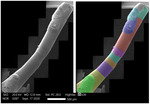
Technological analysis and experimental reproduction of the techniques of perforation of quartz beads from the Ceramic period in the AntillesMadeleine Raymond, Pierrick Fouéré, Ronan Ledevin, Yannick Lefrais and Alain Queffelec https://osf.io/preprints/socarxiv/a5tgpUsing Cactus Thorns to Drill Quartz: A Proof of ConceptRecommended by Donatella Usai and Jonathan Hanna based on reviews by Viola Stefano, ? and 1 anonymous reviewer based on reviews by Viola Stefano, ? and 1 anonymous reviewer
Quartz adornments (beads, pendants, etc.) are frequent artifacts found in the Caribbean, particularly from Early Ceramic Age contexts (~500 BC-AD 700). As a form of specialization, these are sometimes seen as indicative of greater social complexity and craftsmanship during this time. Indeed, ethnographic analogy has purported that such stone adornments require enormous inputs of time and labor, as well as some technological sophistication with tools hard-enough to create the holes (e.g., metal or diamonds). However, given these limitations, one would expect unfinished beads to be a common artifact in the archaeological record. Yet, whereas unworked/raw materials are often found, beads with partial/unfinished perforations are not. References:
| Technological analysis and experimental reproduction of the techniques of perforation of quartz beads from the Ceramic period in the Antilles | Madeleine Raymond, Pierrick Fouéré, Ronan Ledevin, Yannick Lefrais and Alain Queffelec | <p style="text-align: justify;">Personal ornaments are a very specific kind of material production in human societies and are particularly valuable artifacts for the archaeologist seeking to understand past societies. In the Caribbean, Early Ceram... |  | Lithic technology, Neolithic, South America, Symbolic behaviours, Traceology | Donatella Usai | 2022-09-06 14:01:51 | View | |
03 Nov 2023
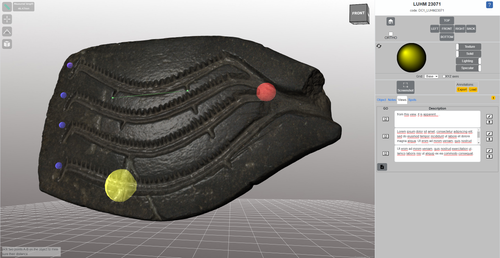
The Dynamic Collections – a 3D Web Platform of Archaeological Artefacts designed for Data Reuse and Deep InteractionMarco Callieri, Åsa Berggren, Nicolò Dell’Unto, Paola Derudas, Domenica Dininno, Fredrik Ekengren, Giuseppe Naponiello https://doi.org/10.5281/zenodo.10067103A comparative teaching and learning tool for 3D data: Dynamic CollectionsRecommended by Sebastian Hageneuer based on reviews by Alex Brandsen and Louise Tharandt based on reviews by Alex Brandsen and Louise Tharandt
The paper (Callieri, M. et al. 2023) describes the “Dynamic Collections” project, an online platform initially created to showcase digital archaeological collections of Lund University. During a phase of testing by department members, new functionalities and artefacts were added resulting in an interactive platform adapted to university-level teaching and learning. The paper introduces into the topic and related works after which it starts to explain the project itself. The idea is to resemble the possibilities of interaction of non-digital collections in an online platform. Besides the objects themselves, the online platform offers annotations, measurement and other interactive tools based on the already known 3DHOP framework. With the possibility to create custom online collections a collaborative working/teaching environment can be created. The already wide-spread use of the 3DHOP framework enabled the authors to develop some functionalities that could be used in the “Dynamic Collections” project. Also, current and future plans of the project are discussed and will include multiple 3D models for one object or permanent identifiers, which are both important additions to the system. The paper then continues to explain some of its further planned improvements, like comparisons and support for teaching, which will make the tool an important asset for future university-level education. The paper in general is well-written and informative and introduces into the interactive tool, that is already available and working. It is very positive, that the authors rely on up-to-date methodologies in creating 3D online repositories and are in fact improving them by testing the tool in a teaching environment. They mention several times the alignment with upcoming EU efforts related to the European Collaborative Cloud for Cultural Heritage (ECCCH), which is anticipatory and far-sighted and adds to the longevity of the project. Comments of the reviewers were reasonably implemented and led to a clearer and more concise paper. I am very confident that this tool will find good use in heritage research and presentation as well as in university-level teaching and learning. Although the authors never answer the introductory question explicitly (What characteristics should a virtual environment have in order to trigger dynamic interaction?), the paper gives the implicit answer by showing what the "Dynamic Collections" project has achieved and is able to achieve in the future. BibliographyCallieri, M., Berggren, Å., Dell'Unto, N., Derudas, P., Dininno, D., Ekengren, F., and Naponiello, G. (2023). The Dynamic Collections – a 3D Web Platform of Archaeological Artefacts designed for Data Reuse and Deep Interaction, Zenodo, 10067103, ver. 3 peer-reviewed and recommended by Peer Community in Archaeology. https://doi.org/10.5281/zenodo.10067103 | The Dynamic Collections – a 3D Web Platform of Archaeological Artefacts designed for Data Reuse and Deep Interaction | Marco Callieri, Åsa Berggren, Nicolò Dell’Unto, Paola Derudas, Domenica Dininno, Fredrik Ekengren, Giuseppe Naponiello | <p>The Dynamic Collections project is an ongoing initiative pursued by the Visual Computing Lab ISTI-CNR in Italy and the Lund University Digital Archaeology Laboratory-DARKLab, Sweden. The aim of this project is to explore the possibilities offer... |  | Archaeometry, Computational archaeology | Sebastian Hageneuer | 2023-08-31 15:05:32 | View | |
20 Dec 2020
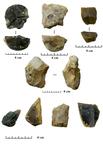
For our world without sound. The opportunistic debitage in the Italian context: a methodological evaluation of the lithic assemblages of Pirro Nord, Cà Belvedere di Montepoggiolo, Ciota Ciara cave and Riparo Tagliente.Marco Carpentieri, Marta Arzarello https://doi.org/10.31219/osf.io/2ptjbInvestigating the opportunistic debitage – an experimental approachRecommended by Alice Leplongeon based on reviews by David Hérisson and 1 anonymous reviewerThe paper “For our world without sound. The opportunistic debitage in the Italian context: a methodological evaluation of the lithic assemblages of Pirro Nord, Cà Belvedere di Montepoggiolo, Ciota Ciara cave and Riparo Tagliente” [1] submitted by M. Carpentieri and M. Arzarello is a welcome addition to a growing number of studies focusing on flaking methods showing little to no core preparation, e.g., [2–4]. These flaking methods are often overlooked or seen as ‘simple’, which, in a Middle Palaeolithic context, sometimes leads to a dichotomy of Levallois vs. non-Levallois debitage (e.g., see discussion in [2]). The authors address this topic by first providing a definition for ‘opportunistic debitage’, derived from the definition of the ‘Alternating Surfaces Debitage System’ (SSDA, [5]). At the core of the definition is the adaptation to the characteristics (e.g., natural convexities and quality) of the raw material. This is one main challenge in studying this type of debitage in a consistent way, as the opportunistic debitage leads to a wide range of core and flake morphologies, which have sometimes been interpreted as resulting from different technical behaviours, but which the authors argue are part of a same ‘methodological substratum’ [1]. This article aims to further characterise the ‘opportunistic debitage’. The study relies on four archaeological assemblages from Italy, ranging from the Lower to the Upper Pleistocene, in which the opportunistic debitage has been recognised. Based on the characteristics associated with the occurrence of the opportunistic debitage in these assemblages, an experimental replication of the opportunistic debitage using the same raw materials found at these sites was conducted, with the aim to gain new insights into the method. Results show that experimental flakes and cores are comparable to the ones identified as resulting from the opportunistic debitage in the archaeological assemblage, and further highlight the high versatility of the opportunistic method. One outcome of the experimental replication is that a higher flake productivity is noted in the opportunistic centripetal debitage, along with the occurrence of 'predetermined-like' products (such as déjeté points). This brings the authors to formulate the hypothesis that the opportunistic debitage may have had a role in the process that will eventually lead to the development of Levallois and Discoid technologies. How this articulates with for example current discussions on the origins of Levallois technologies (e.g., [6–8]) is an interesting research avenue. This study also touches upon the question of how the implementation of one knapping method may be influenced by the broader technological knowledge of the knapper(s) (e.g., in a context where Levallois methods were common vs a context where they were not). It makes the case for a renewed attention in lithic studies for flaking methods usually considered as less behaviourally significant. [1] Carpentieri M, Arzarello M. 2020. For our world without sound. The opportunistic debitage in the Italian context: a methodological evaluation of the lithic assemblages of Pirro Nord, Cà Belvedere di Montepoggiolo, Ciota Ciara cave and Riparo Tagliente. OSF Preprints, doi:10.31219/osf.io/2ptjb [2] Bourguignon L, Delagnes A, Meignen L. 2005. Systèmes de production lithique, gestion des outillages et territoires au Paléolithique moyen : où se trouve la complexité ? Editions APDCA, Antibes, pp. 75–86. Available: https://halshs.archives-ouvertes.fr/halshs-00447352 [3] Arzarello M, De Weyer L, Peretto C. 2016. The first European peopling and the Italian case: Peculiarities and “opportunism.” Quaternary International, 393: 41–50. doi:10.1016/j.quaint.2015.11.005 [4] Vaquero M, Romagnoli F. 2018. Searching for Lazy People: the Significance of Expedient Behavior in the Interpretation of Paleolithic Assemblages. J Archaeol Method Theory, 25: 334–367. doi:10.1007/s10816-017-9339-x [5] Forestier H. 1993. Le Clactonien : mise en application d’une nouvelle méthode de débitage s’inscrivant dans la variabilité des systèmes de production lithique du Paléolithique ancien. Paléo, 5: 53–82. doi:10.3406/pal.1993.1104 [6] Moncel M-H, Ashton N, Arzarello M, Fontana F, Lamotte A, Scott B, et al. 2020. Early Levallois core technology between Marine Isotope Stage 12 and 9 in Western Europe. Journal of Human Evolution, 139: 102735. doi:10.1016/j.jhevol.2019.102735 [7] White M, Ashton N, Scott B. 2010. The emergence, diversity and significance of the Mode 3 (prepared core) technologies. Elsevier. In: Ashton N, Lewis SG, Stringer CB, editors. The ancient human occupation of Britain. Elsevier. Amsterdam, pp. 53–66. [8] White M, Ashton N. 2003. Lower Palaeolithic Core Technology and the Origins of the Levallois Method in North‐Western Europe. Current Anthropology, 44: 598–609. doi:10.1086/377653 | For our world without sound. The opportunistic debitage in the Italian context: a methodological evaluation of the lithic assemblages of Pirro Nord, Cà Belvedere di Montepoggiolo, Ciota Ciara cave and Riparo Tagliente. | Marco Carpentieri, Marta Arzarello | <p>The opportunistic debitage, originally adapted from Forestier’s S.S.D.A. definition, is characterized by a strong adaptability to local raw material morphology and its physical characteristics and it is oriented towards flake production. Its mo... |  | Ancient Palaeolithic, Lithic technology, Middle Palaeolithic | Alice Leplongeon | 2020-07-23 14:26:04 | View | |
17 Jun 2022
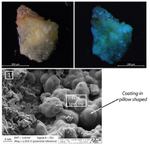
Light in the Cave: Opal coating detection by UV-light illumination and fluorescence in a rock art context. Methodological development and application in Points Cave (Gard, France)Marine Quiers, Claire Chanteraud, Andréa Maris-Froelich, Émilie Chalmin-Aljanabi, Stéphane Jaillet, Camille Noûs, Sébastien Pairis, Yves Perrette, Hélène Salomon, Julien Monney https://hal.archives-ouvertes.fr/hal-03383193v5New method for the in situ detection and characterisation of amorphous silica in rock art contextsRecommended by Aitor Ruiz-Redondo based on reviews by Alain Queffelec, Laure Dayet and 1 anonymous reviewerSilica coating developed in cave art walls had an impact in the preservation of the paintings themselves. Despite it still exists a controversy about whether or not the effects contribute to the preservation of the artworks; it is evident that identifying these silica coatings would have an impact to assess the taphonomy of the walls and the paintings preserved on them. Unfortunately, current techniques -especially non-invasive ones- can hardly address amorphous silica characterisation. Thus, its presence is often detected on laboratory observations such as SEM or XRD analyses. In the paper “Light in the Cave: Opal coating detection by UV-light illumination and fluorescence in a rock art context - Methodological development and application in Points Cave (Gard, France)”, Quiers and collaborators propose a new method for the in situ detection and characterisation of amorphous silica in a rock art context based on UV laser-induced fluorescence (LIF) and UV illumination [1]. The results from both methods presented by the authors are convincing for the detection of U-silica mineralisation (U-opal in the specific case of study presented). This would allow access to a fast and cheap method to identify this kind of formations in situ in decorated caves. Beyond the relationship between opal coating and the preservation of the rock art, the detection of silica mineralisation can have further implications. First, it can help to define spot for sampling for pigment compositions, as well as reconstruct the chronology of the natural history of the caves and its relation with the human frequentation and activities. In conclusion, I am glad to recommend this original research, which offers a new approach to the identification of geological processes that affect -and can be linked with- the Palaeolithic cave art. [1] Quiers, M., Chanteraud, C., Maris-Froelich, A., Chalmin-Aljanabi, E., Jaillet, S., Noûs, C., Pairis, S., Perrette, Y., Salomon, H., Monney, J. (2022) Light in the Cave: Opal coating detection by UV-light illumination and fluorescence in a rock art context. Methodological development and application in Points Cave (Gard, France). HAL, hal-03383193, ver. 5 peer-reviewed and recommended by Peer community in Archaeology. https://hal.archives-ouvertes.fr/hal-03383193v5 | Light in the Cave: Opal coating detection by UV-light illumination and fluorescence in a rock art context. Methodological development and application in Points Cave (Gard, France) | Marine Quiers, Claire Chanteraud, Andréa Maris-Froelich, Émilie Chalmin-Aljanabi, Stéphane Jaillet, Camille Noûs, Sébastien Pairis, Yves Perrette, Hélène Salomon, Julien Monney | <p style="text-align: justify;">Silica coatings development on rock art walls in Points Cave questions the analytical access to pictorial matter specificities (geochemistry and petrography) and the rock art conservation state in the context of pig... |  | Archaeometry, Europe, Rock art, Taphonomy, Upper Palaeolithic | Aitor Ruiz-Redondo | 2021-10-25 11:12:48 | View | |
02 Sep 2023
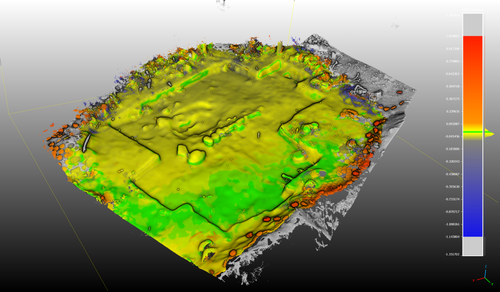
Towards a Mobile 3D Documentation Solution. Video Based Photogrammetry and iPhone 12 Pro as Fieldwork Documentation ToolsNikolai Paukkonen https://doi.org/10.5281/zenodo.7954534The Potential of Mobile 3D Documentation using Video Based Photogrammetry and iPhone 12 ProRecommended by Ying Tung Fung based on reviews by Dominik Hagmann, Sebastian Hageneuer and 1 anonymous reviewerI am pleased to recommend the paper titled "Towards a Mobile 3D Documentation Solution. Video Based Photogrammetry and iPhone 12 Pro as Fieldwork Documentation Tools" for consideration and publication as a preprint (Paukkonen, 2023). The paper addresses a timely and relevant topic within the field of archaeology and offers valuable insights into the evolving landscape of 3D documentation methods. The advances in technology over the past decade have brought about significant changes in archaeological documentation practices. This paper makes a valuable contribution by discussing the emergence of affordable equipment suitable for 3D fieldwork documentation. Given the constraints that many archaeologists face with limited resources and tight timeframes, the comparison between photogrammetry based on a video captured by a DJI Osmo Pocket gimbal camera and iPhone 12 Pro LiDAR scans is of great significance. The research presented in the paper showcases a practical application of these new technologies in the context of a Finnish Early Modern period archaeological project. By comparing the acquisition processes and evaluating the accuracy, precision, ease of use, and time constraints associated with each method, the authors provide a comprehensive assessment of their potential for archaeological fieldwork. This practical approach is a commendable aspect of the paper, as it not only explores the technical aspects but also considers the practical implications for archaeologists on the ground. Furthermore, the paper appropriately addresses the limitations of these technologies, specifically highlighting their potential inadequacy for projects requiring a higher level of precision, such as Neolithic period excavations. This nuanced perspective adds depth to the discussion and provides a realistic portrayal of the strengths and limitations of the new documentation methods. In conclusion, the paper offers valuable insights into the future of 3D field documentation for archaeologists. The authors' thorough evaluation and practical approach make this study a valuable resource for researchers, practitioners, and professionals in the field. I believe that this paper would be an excellent addition to PCIArchaeology and would contribute significantly to the ongoing dialogue within the archaeological community. References Paukkonen, N. (2023) Towards a Mobile 3D Documentation Solution. Video Based Photogrammetry and iPhone 12 Pro as Fieldwork Documentation Tools, Zenodo, 8281263, ver. 3 peer-reviewed and recommended by Peer Community in Archaeology. https://doi.org/10.5281/zenodo.8281263 | Towards a Mobile 3D Documentation Solution. Video Based Photogrammetry and iPhone 12 Pro as Fieldwork Documentation Tools | Nikolai Paukkonen | <p>New affordable equipment suitable for 3D fieldwork documentation has appeared during the last years. Both photogrammetry and laser scanning are becoming affordable for archaeologists, who often work with limited resources and tight time constra... |  | Europe, Post-medieval, Remote sensing | Ying Tung Fung | 2023-05-21 21:32:33 | View | |
20 Jul 2022

Faunal remains from the Upper Paleolithic site of Nahal Rahaf 2 in the southern Judean Desert, IsraelNimrod Marom, Dariya Lokshin Gnezdilov, Roee Shafir, Omry Barzilai, Maayan Shemer https://www.biorxiv.org/content/10.1101/2022.05.17.492258v4New zooarchaeological data from the Upper Palaeolithic site of Nahal Rahaf 2, IsraelRecommended by Ruth Blasco based on reviews by Ana Belén Galán and Joana Gabucio based on reviews by Ana Belén Galán and Joana Gabucio
The Levantine Corridor is considered a crossing point to Eurasia and one of the main areas for detecting population flows (and their associated cultural and economic changes) during the Pleistocene. This area could have been closed during the most arid periods, giving rise to processes of population isolation between Africa and Eurasia and intermittent contact between Eurasian human communities [1,2]. Zooarchaeological studies of the early Upper Palaeolithic assemblages constitute an important source of knowledge about human subsistence, making them central to the debate on modern behaviour. The Early Upper Palaeolithic sequence in the Levant includes two cultural entities – the Early Ahmarian and the Levantine Aurignacian. This latter is dated to 39-33 ka and is considered a local adaptation of the European Aurignacian techno-complex. In this work, the authors present a zooarchaeological study of the Nahal Rahaf 2 (ca. 35 ka) archaeological site in the southern Judean Desert in Israel [3]. Zooarchaeological data from the early Upper Paleolithic desert regions of the southern Levant are not common due to preservation problems of non-lithic finds. In the case of Nahal Rahaf 2, recent excavation seasons brought to light a stratigraphical sequence composed of very well-preserved archaeological surfaces attributed to the 'Arkov-Divshon' cultural entity, which is associated with the Levantine Aurignacian. This study shows age-specific caprine (Capra cf. Capra ibex) hunting on prime adults and a generalized procurement of gazelles (Gazella cf. Gazella gazella), which seem to have been selectively transported to the site and processed for within-bone nutrients. An interesting point to note is that the proportion of goats increases along the stratigraphic sequence, which suggests to the authors a specialization in the economy over time that is inversely related to the occupational intensity of use of the site. It is also noteworthy that the materials represent a large sample compared to previous studies from the Upper Paleolithic of the Judean Desert and Negev. In summary, this manuscript contributes significantly to the study of both the palaeoenvironment and human subsistence strategies in the Upper Palaeolithic and provides another important reference point for evaluating human hunting adaptations in the arid regions of the southern Levant. References [1] Bermúdez de Castro, J.-L., Martinon-Torres, M. (2013). A new model for the evolution of the human pleistocene populations of Europe. Quaternary Int. 295, 102-112. https://doi.org/10.1016/j.quaint.2012.02.036 [2] Bar-Yosef, O., Belfer-Cohen, A. (2010). The Levantine Upper Palaeolithic and Epipalaeolithic. In Garcea, E.A.A. (Ed), South-Eastern Mediterranean Peoples Between 130,000 and 10,000 Years Ago. Oxbow Books, pp. 144-167. [3] Marom, N., Gnezdilov, D. L., Shafir, R., Barzilai, O. and Shemer, M. (2022). Faunal remains from the Upper Paleolithic site of Nahal Rahaf 2 in the southern Judean Desert, Israel. BioRxiv, 2022.05.17.492258, ver. 4 peer-reviewed and recommended by Peer community in Archaeology. https://www.biorxiv.org/content/10.1101/2022.05.17.492258v4 | Faunal remains from the Upper Paleolithic site of Nahal Rahaf 2 in the southern Judean Desert, Israel | Nimrod Marom, Dariya Lokshin Gnezdilov, Roee Shafir, Omry Barzilai, Maayan Shemer | <p>Nahal Rahaf 2 (NR2) is an Early Upper Paleolithic (ca. 35 kya) rock shelter in the southern Judean Desert in Israel. Two excavation seasons in 2019 and 2020 revealed a stratigraphical sequence composed of intact archaeological surfaces attribut... |  | Upper Palaeolithic, Zooarchaeology | Ruth Blasco | Joana Gabucio | 2022-05-19 06:16:47 | View |
MANAGING BOARD
Alain Queffelec
Marta Arzarello
Ruth Blasco
Otis Crandell
Luc Doyon
Sian Halcrow
Emma Karoune
Aitor Ruiz-Redondo
Philip Van Peer










